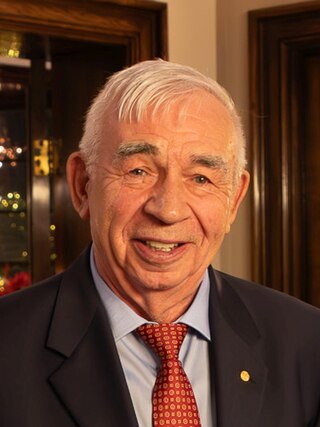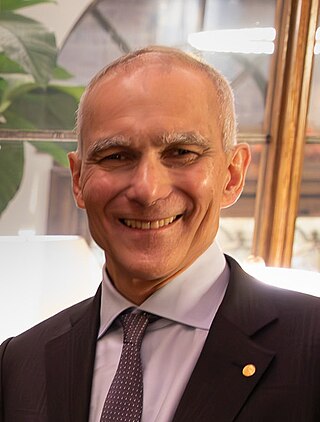
Quantum dots (QDs) or semiconductor nanocrystals are semiconductor particles a few nanometres in size with optical and electronic properties that differ from those of larger particles via quantum mechanical effects. They are a central topic in nanotechnology and materials science. When a quantum dot is illuminated by UV light, an electron in the quantum dot can be excited to a state of higher energy. In the case of a semiconducting quantum dot, this process corresponds to the transition of an electron from the valence band to the conductance band. The excited electron can drop back into the valence band releasing its energy as light. This light emission (photoluminescence) is illustrated in the figure on the right. The color of that light depends on the energy difference between the conductance band and the valence band, or the transition between discrete energy states when the band structure is no longer well-defined in QDs.

A potential well is the region surrounding a local minimum of potential energy. Energy captured in a potential well is unable to convert to another type of energy because it is captured in the local minimum of a potential well. Therefore, a body may not proceed to the global minimum of potential energy, as it would naturally tend to do due to entropy.

Armand Paul Alivisatos is a Greek-American etymologist, chemist and academic administrator who has served as the 14th president of the University of Chicago since September 2021. He is a pioneer in nanomaterials development and an authority on the fabrication of nanocrystals and their use in biomedical and renewable energy applications. He was ranked fifth among the world's top 100 chemists for the period 2000–2010 in the list released by Thomson Reuters.

Cadmium selenide is an inorganic compound with the formula CdSe. It is a black to red-black solid that is classified as a II-VI semiconductor of the n-type. It is a pigment, but applications are declining because of environmental concerns.

A quantum dot solar cell (QDSC) is a solar cell design that uses quantum dots as the captivating photovoltaic material. It attempts to replace bulk materials such as silicon, copper indium gallium selenide (CIGS) or cadmium telluride (CdTe). Quantum dots have bandgaps that are adjustable across a wide range of energy levels by changing their size. In bulk materials, the bandgap is fixed by the choice of material(s). This property makes quantum dots attractive for multi-junction solar cells, where a variety of materials are used to improve efficiency by harvesting multiple portions of the solar spectrum.

Louis Eugene Brus is an American chemist, and currently the Samuel Latham Mitchell Professor of Chemistry at Columbia University. He is the co-discoverer of the colloidal semi-conductor nanocrystals known as quantum dots. In 2023, he was awarded the Nobel Prize in Chemistry.
Arthur J. Nozik is a researcher at the National Renewable Energy Lab (NREL). He is also a professor at the University of Colorado, which is located in Boulder. He researches semiconductor quantum dots at the National Renewable Energy Laboratory, and is a chemistry professor at the University of Colorado. He also does research for the advancement of solar energy, for which he won the Intergovernmental Renewable Energy Organization (IREO) Award for Science and Technology in 2009.

Alexey Ekimov or Aleksey Yekimov is a Russian solid state physicist and a pioneer in nanomaterials research. He discovered the semiconductor nanocrystals known as quantum dots in 1981, while working at the Vavilov State Optical Institute. In 2023, he was awarded the Nobel Prize in Chemistry for this discovery.

Core–shell semiconducting nanocrystals (CSSNCs) are a class of materials which have properties intermediate between those of small, individual molecules and those of bulk, crystalline semiconductors. They are unique because of their easily modular properties, which are a result of their size. These nanocrystals are composed of a quantum dot semiconducting core material and a shell of a distinct semiconducting material. The core and the shell are typically composed of type II–VI, IV–VI, and III–V semiconductors, with configurations such as CdS/ZnS, CdSe/ZnS, CdSe/CdS, and InAs/CdSe Organically passivated quantum dots have low fluorescence quantum yield due to surface related trap states. CSSNCs address this problem because the shell increases quantum yield by passivating the surface trap states. In addition, the shell provides protection against environmental changes, photo-oxidative degradation, and provides another route for modularity. Precise control of the size, shape, and composition of both the core and the shell enable the emission wavelength to be tuned over a wider range of wavelengths than with either individual semiconductor. These materials have found applications in biological systems and optics.
Blinking colloidal nanocrystals is a phenomenon observed during studies of single colloidal nanocrystals that show that they randomly turn their photoluminescence on and off even under continuous light illumination. This has also been described as luminescence intermittency. Similar behavior has been observed in crystals made of other materials. For example, porous silicon also exhibits this affect.
Quantum dots (QDs) are semiconductor nanoparticles with a size less than 10 nm. They exhibited size-dependent properties especially in the optical absorption and the photoluminescence (PL). Typically, the fluorescence emission peak of the QDs can be tuned by changing their diameters. So far, QDs were consisted of different group elements such as CdTe, CdSe, CdS in the II-VI category, InP or InAs in the III-V category, CuInS2 or AgInS2 in the I–III–VI2 category, and PbSe/PbS in the IV-VI category. These QDs are promising candidates as fluorescent labels in various biological applications such as bioimaging, biosensing and drug delivery.
Klavs Flemming Jensen is a chemical engineer who is currently the Warren K. Lewis Professor at the Massachusetts Institute of Technology (MIT).

Moungi Bawendi is an American–Tunisian–French chemist. He is currently the Lester Wolfe Professor at the Massachusetts Institute of Technology. Bawendi is known for his advances in the chemical production of high-quality quantum dots. For this work, he was awarded the Nobel Prize in Chemistry in 2023.
Prashant Jain is an Indian-born American scientist and a professor of chemistry at the University of Illinois Urbana–Champaign where his research laboratory studies the interaction of light with matter, designs nanoparticle catalysts, and develops methods for mimicking plant photosynthesis. He is a Fellow of the American Association for the Advancement of Science and the Royal Society of Chemistry, a TR35 inventor, a Sloan Fellow, a PECASE recipient, a Royal Society of Chemistry Beilby medalist, and a top-cited researcher in chemical sciences.

Vicki Leigh Colvin is a professor of engineering and molecular pharmacology at Brown University, and has been selected as the next dean of the Louisiana State University College of Engineering. At Brown, she is the director of the Centre for Biomedical Engineering. Her work focuses on the synthesis and characterization of nanomaterials. She is a Fellow of the American Association for the Advancement of Science and the American Institute for Medical and Biological Engineering.
Sandra J. Rosenthal is the Jack and Pamela Egan Professor of Chemistry, professor of physics and astronomy, pharmacology, chemical and biomolecular engineering, and materials science at Vanderbilt University. She is a joint faculty member at Oak Ridge National Laboratory in the Materials Science and Technology Division and the director of the Vanderbilt Institute of Nanoscale Science and Engineering.
Uri Banin is an Israeli nanotechnologist and physical chemist and a professor at the Hebrew University of Jerusalem, currently holding the Alfred & Erica Larisch Memorial Chair at the Institute of Chemistry. He is recognized as one of the pioneers of nanoscience in Israel.
Hedi Mattoussi is a Tunisian-American materials scientist and professor at Florida State University. His research considers colloidal inorganic nanocrystals for biological imaging and sensing. He is a Fellow of the American Physical Society, American Chemical Society and Materials Research Society.
Silicon quantum dots are metal-free biologically compatible quantum dots with photoluminescence emission maxima that are tunable through the visible to near-infrared spectral regions. These quantum dots have unique properties arising from their indirect band gap, including long-lived luminescent excited-states and large Stokes shifts. A variety of disproportionation, pyrolysis, and solution protocols have been used to prepare silicon quantum dots, however it is important to note that some solution-based protocols for preparing luminescent silicon quantum dots actually yield carbon quantum dots instead of the reported silicon. The unique properties of silicon quantum dots lend themselves to an array of potential applications: biological imaging, luminescent solar concentrators, light emitting diodes, sensors, and lithium-ion battery anodes.
Christopher Bruce Murray is the Richard Perry University Professor of Chemistry and Materials Science and Engineering at the University of Pennsylvania. He is a member of the National Academy of Engineering and a Fellow of the Materials Research Society. He was a Clarivate Citation Laureate in 2020. He is known for his contributions to quantum dots and other nanoscale materials.










